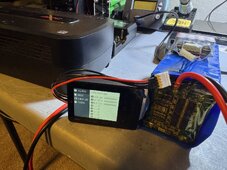I have built a 3S7P 18650 battery pack using Sony VTC6 cells to be used in a 12V 7AH battery case kit from AliExpress for a UPS. I have two UPS models, one with a 350VA capacity and another with 750VA. Both UPS units have a charging voltage of 13.5V at either 10W or 20W.
The issue I am facing is that with that UPS charging voltage my battery will exceed the voltage of 12.6V, which is the maximum I want for each cell (4.2V per cell, with 4.15V being my preference). This high voltage could potentially damage the batteries since the BMS cutoff is at 4.3V or 12.9V.
Is there any way to regulate the UPS charging voltage or modify the BMS to cut the voltage at 4.1V, for example?

The issue I am facing is that with that UPS charging voltage my battery will exceed the voltage of 12.6V, which is the maximum I want for each cell (4.2V per cell, with 4.15V being my preference). This high voltage could potentially damage the batteries since the BMS cutoff is at 4.3V or 12.9V.
Is there any way to regulate the UPS charging voltage or modify the BMS to cut the voltage at 4.1V, for example?




